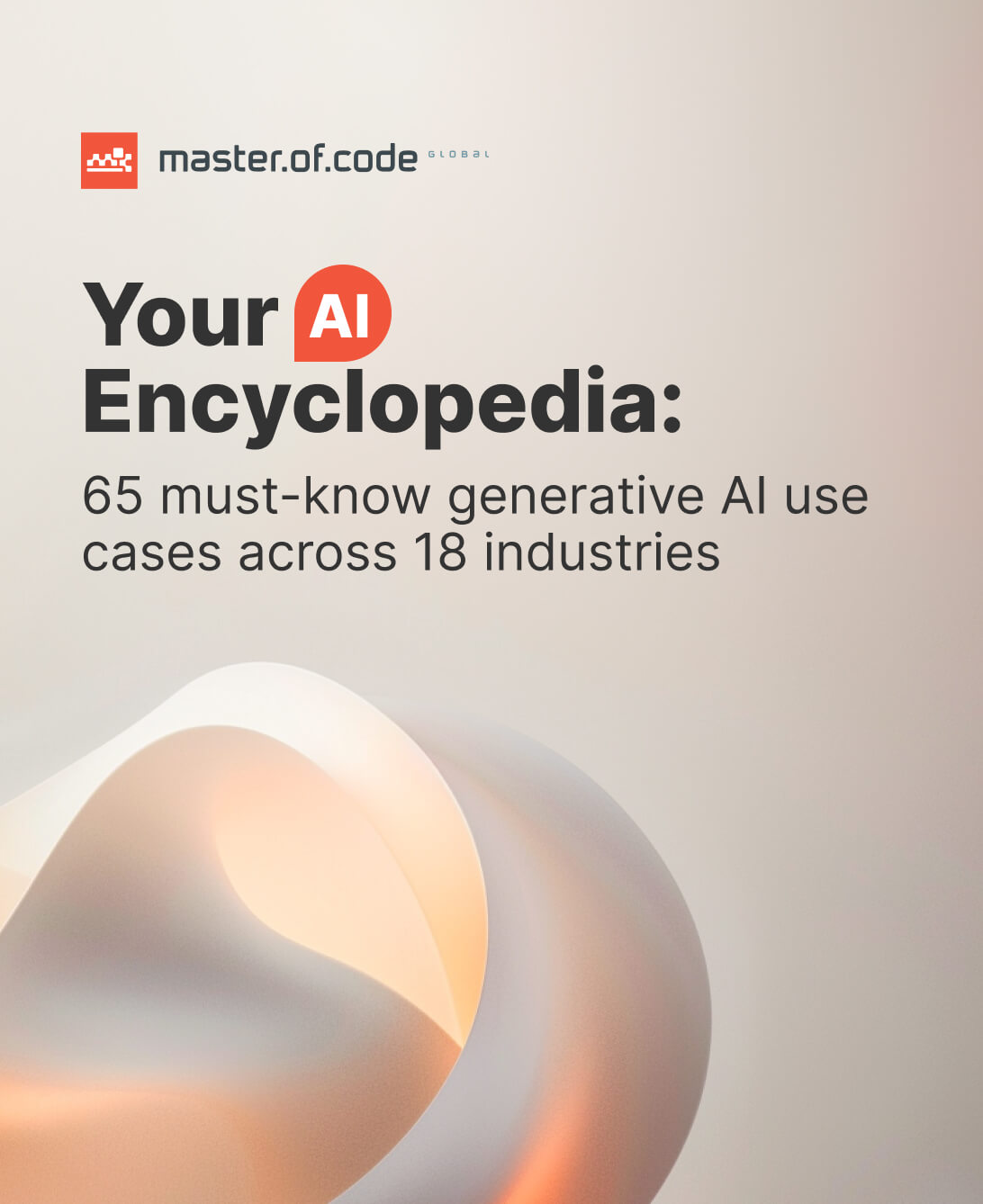From global financial giants like Visa to agile innovators like Form3 and Wex, organizations are actively investing in GenAI to streamline operations, enhance fraud detection, and personalize customer experiences.
According to a recent Accenture study, leading banks have already automated 40% of manual tasks using Generative AI in payments, marking a pivotal shift in how financial transactions are processed, secured, and analyzed. Furthermore, industry analysts estimate that adopting GAI could unlock $200–$340 billion in annual value.
In this article, we dive deep into GenAI’s potential in the payments space, AI use cases in finance, examine real-world success stories, explore risks such as cybersecurity and bias, and outline a responsible roadmap for implementation.
Whether you’re a fintech innovator or an enterprise looking to modernize your operations, this guide on Generative AI for payment providers explores how they can drive efficiency, innovation, and resilience across your business.
Learn from 200+ finance executives about working AI solutions, risk management, and ROI they’re seeing.

Table of Contents
Core Generative AI Use Cases in Payments Can Impact Your Business
To demonstrate how innovative technologies can help, let’s take a look at business use cases for Generative AI.
Payments Process Management
GAI is reshaping how businesses execute and manage financial operations, bringing speed, accuracy, and consistency to some of the most time-consuming tasks. This transformation is particularly evident with the use of Generative AI in commercial payments, where high transaction volumes and complex workflows demand advanced automation and intelligent data processing.
- Invoice processing: Generative AI tools can extract structured data from emailed or scanned invoices, such as amounts, dates, vendor IDs, and terms. This process replaces manual information entry and integrates directly into ERP and accounting workflows.
- Reconciliation: GenAI systems can cross-check records against invoices and payment confirmations in real time. This reduces mismatches, shortens closing cycles, and eliminates manual spreadsheet work.
- Authorization: AI models assess risk based on customer behavior, transaction patterns, and external data. This enables faster decision-making and minimizes false declines at checkout, an essential metric for both client satisfaction and revenue protection.
- Remittance: Automated handling of outbound operations ensures that funds are routed correctly and on time. Artificial Intelligence helps flag anomalies or inconsistencies before the payment is processed, minimizing costly errors.
- Collection: By analyzing when and how customers are most likely to respond, AI designs personalized collection strategies. This improves timeliness and minimizes unnecessary escalation efforts.
- Declaration: When it comes to regulatory reporting or internal audit readiness, GenAI can pull relevant data into structured summaries, reducing the burden on finance teams and improving compliance accuracy.
- Credit card checkout: By pre-filling form fields, validating entries in real time, and identifying potential fraud before authorization, GenAI elevates both the speed and security of card payments, especially for eCommerce.
Real-Time Fraud Prevention
With global digital fraud losses projected to exceed $343 billion by 2027, more businesses are considering using Generative AI to combat the surge in cybercrime. Traditional systems, reliant on static rules and manual updates, often fall behind as fraudsters invent new tactics. As a result, financial institutions struggle to capture threats fast enough, leading to costly breaches, compliance risks, and erosion of customer trust.
A Generative AI-powered fraud solution brings adaptability and precision into the fight against financial crime. Unlike static systems, these models continuously learn from evolving datasets, recognizing subtle anomalies and correlations that humans or legacy algorithms might miss. Through real-time monitoring and pattern recognition, they can flag irregular behaviors the instant they occur, before they turn into costly breaches.
GAI helps institutions address three core fraud categories effectively:
- Transaction Monitoring:
Intelligent models process both historical and streaming data to identify irregular spending habits, duplicate payments, or unusual transaction velocities. By analyzing patterns across accounts, merchants, and geographies, they can flag suspicious activity in real-time, minimizing potential harm and reducing customer disruption. - Anomalies Detection:
The system detects inconsistencies like mismatched geolocations, abnormal payment volumes, or atypical device metadata. For example, if a user who typically pays under $1,000 suddenly initiates a $10,000 international transfer, it triggers an instant review. GenAI’s contextual awareness ensures accuracy while minimizing false positives. - Detecting Billing Scheme Fraud in Recurring Invoices:
In enterprise finance, schemes of this kind are difficult to catch. Generative AI can cross-check invoices against prior patterns, payment terms, and historical norms, identifying subtle irregularities such as unauthorized edits or timing anomalies that indicate possible fraud.
The Generative AI benefits for business in fraud prevention extend beyond immediate threat detection:
- Proactive security: Systems adapt automatically to new techniques.
- Operational efficiency: Automation reduces the need for manual investigations.
- Cost savings: Early detection minimizes financial losses and compliance penalties.
- Customer trust: Secure and seamless transactions reinforce confidence in digital banking.
As tactics evolve, GenAI-driven fraud detection marks a turning point from reactive defense to predictive intelligence. These adaptive systems not only identify threats faster but also anticipate them, continuously refining their understanding of legitimate versus suspicious behavior.
Generative AI Chatbots Adoption
According to a recent Salesforce report, 81% of customers expect faster assistance as technology advances, and 65% already prefer self-service tools for simple issues. Chatbots meet both expectations by offering 24/7 instant support, natural language understanding, and contextual responses.
Moreover, these bots offer tailored product or service recommendations based on buyers’ preferences. Their adoption benefits businesses with higher retention rates. Additionally, you will experience significant cost savings by cutting down the need for customer support, especially for high-volume interactions like peer-to-peer (P2P) payments or account inquiries. Furthermore, virtual assistants gather valuable data on client communication for more targeted marketing efforts.
Read also: Putting Banking Chatbots to the Test
Reports Automation
An interesting fact is that around 61.5% of companies with 11-1000 employees are using Generative AI in the workplace. What’s even more exciting is that 75% of users aim to automate tasks at work by implementing this technology. It eliminates labor-intensive workflows, delivering results far faster than human teams could achieve.
Moreover, this tech efficiently processes vast amounts of data from various sources, generating insightful reports. Algorithms can identify trends, anomalies, and correlations within the data. The advantages are obvious: time and resource savings, previously spent on manual tasks. Additionally, the speed and accuracy of AI-generated reports will help businesses make more informed and timely decisions, enhancing their competitiveness.
Structured Data Enchantment
Algorithms are capable of cleaning, organizing, and augmenting data. With enhancements like these, companies can ensure information accuracy, consistency, and completeness. Such quality is pivotal in deriving meaningful insights and making calculated decisions.
Other evident advantages are more accurate analytics, better strategic planning, and forecasting. Plus, this structured data enrichment empowers organizations to uncover hidden patterns or trends that might otherwise go unnoticed. Summing up, your business intelligence will be more reliable.
Payment Analytics
Within this field, Generative AI delivers the greatest impact across two fronts.
#1. Data Enrichment
GAI enables the conversion of raw, ambiguous transaction data into structured, actionable insights by automatically classifying, enriching, and contextualizing it. This growing capability is reflected in market trends. For instance, one firm found that the global financial processes data enrichment market reached USD 1.62 billion in 2024 and is projected to grow at a compound annual growth rate (CAGR) of 22.5% from 2026 to 2033.
In practice: an algorithm automatically tags merchant names, categorises transactions (e.g., utilities vs. subscriptions), appends geolocation or vendor metadata, and surfaces behavioural patterns that would otherwise sit hidden. This clean, enriched dataset improves everything from reconciliation and cash‑flow forecasting to fraud detection and compliance.
#2. Personalized Risk and Credit Assessments
GAI enables payment providers to evaluate creditworthiness and risk at an individual level. By combining enriched transaction records with alternative data sources and real-time behavioral insights, institutions achieve far greater precision in their checks. Recent research shows that fintech firms using advanced analytics (including machine learning) can predict loan defaults and credit risk more accurately than traditional banks.
For example, payment‑behaviour data (frequency of transactions, cross‑border activity) combined with enriched metadata (merchant category, installment method, device) can form a richer risk score.
How to Mitigate Gen AI Risks in Payments
Data Privacy & Cybersecurity
As Generative AI becomes more embedded in installment workflows, it introduces a new layer of risk around both privacy and cybersecurity. These systems rely on vast volumes of sensitive financial and personal data to function effectively, raising concerns about how that info is collected, processed, and stored.
One of the core risks is unauthorized access to user details, especially when AI models are trained on or exposed to personally identifiable information (PII). If not properly managed, this could lead to privacy violations or even regulatory breaches under frameworks like GDPR, CCPA, or PSD2.
The integration of AI into payment systems also expands the attack surface for cybercriminals. Vulnerabilities in model architecture, APIs, or third-party integrations can be exploited to manipulate transactions, extract sensitive data, or trigger denial-of-service attacks.
To mitigate these risks, organizations must implement strong encryption protocols, role-based access controls, and clear governance policies to ensure compliance and confidentiality.
Ethical & Responsible AI Governance
Embedded Bias
Autonomous systems can unintentionally reinforce historical inequalities if they’re trained on biased datasets. For example, if past payment or credit approvals include discriminatory patterns, the model might perpetuate those outcomes, resulting in unfair credit scoring or transaction blocking for specific user groups. This is especially problematic in global finance ecosystems where user demographics vary widely.
The key to reducing bias lies in data transparency and model governance. Financial institutions can implement bias-aware training pipelines, where datasets are balanced and regularly tested for demographic fairness. Generative AI can even assist in synthetic data generation, creating more equitable materials by supplementing underrepresented groups.
Algorithmic Bias
According to the World Economic Forum, algorithmic bias is a top concern for 72% of financial executives exploring GenAI use. Bias can also emerge in the design of algorithms themselves. Risk models, for instance, may overweight certain features (like location, spending frequency, or device type) that correlate with marginalized groups. Without rigorous audits and diverse training data, intelligent tools risk replicating systemic issues at scale.
Human Oversight
Artificial Intelligence should assist employee decision-making, especially in contexts involving financial inclusion, fraud flags, or declined payments. Establishing clear human-in-the-loop (HITL) protocols ensures that edge cases, ethical dilemmas, or model anomalies are reviewed by trained professionals. Oversight committees and explainable AI tools can further enhance accountability and auditability.
Synthetic Data for Model Training
In the industry, where privacy regulations and data scarcity often limit access to real-world transaction information, synthetic data has emerged as a powerful solution for training language models.
Techniques like Generative Adversarial Networks (GANs) and marginal-based algorithms allow such knowledge to reflect realistic transaction behaviors, enabling models to learn patterns, including fraudulent signals, spending trends, or payment timing. This also entails generating synthetic data for fraud scenarios that are difficult to obtain in real life.
By simulating datasets that mirror the statistical properties of actual records, businesses can accelerate AI development while remaining compliant. Advanced tools like PrivBayes improve precision by injecting controlled noise into low-dimensional data marginals, preserving privacy without sacrificing utility.
Synthetic data is especially valuable for:
- Augmenting limited or imbalanced datasets (e.g., rare fraud cases);
- Addressing privacy concerns in highly regulated financial environments;
- Improving generalization by introducing controlled variability during training.
However, it isn’t flawless. Its accuracy and representativeness compared to real-world data remain a key concern. Overfitting to synthetic patterns can result in unreliable model performance. As such, companies must implement rigorous validation processes to verify that these align with real-world behavior and business outcomes.
Operational Risk Control
As payment volumes surge and user expectations rise, AI helps businesses scale securely without sacrificing service quality or efficiency.
Enhanced Merchant & Customer Support
AI-powered assistants are transforming frontline support by handling high-volume, low-complexity tasks such as checking statuses, updating balances, or answering FAQs. With contactless payments projected to account for over 80% of in-person transactions and digital wallets expected to represent 39% of online purchases by 2027, the pressure to deliver fast, reliable customer service is only intensifying.
Chatbots help meet this demand by providing instant, consistent responses 24/7, reducing wait times, and freeing human agents to manage complex issues. The result? Lower operational costs, higher user satisfaction, and improved client retention.
Reports & Analytics Automation
AI also streamlines internal operations by automating the generation of performance reports and business insights. Rather than relying on manual spreadsheet work, Generative AI can scan large, fragmented datasets and generate tailored summaries, forecasts, or anomaly alerts within seconds, serving as the backbone of intelligent payments automation. This enhances visibility into user behavior, financial health, and market shifts, empowering teams to act quickly and strategically.
Financial Stability
Overreliance on AI systems without adequate fail-safes could lead to systemic failures or errors in transactions. Sudden disruptions in such solutions could have widespread ramifications, affecting financial markets and stability. Accordingly, companies should have contingency plans that are crucial to mitigate such risks and maintain the resilience of their infrastructure.
Regulatory Compliance
As Generative AI becomes more embedded in operations, aligning with global financial regulations is a necessity. From GDPR and CCPA to PSD2 and Basel III, regulatory frameworks demand transparency, fairness, and data protection across every stage of the transaction lifecycle.
One of the key challenges with GenAI in payments is ensuring explainability. Many models operate as “black boxes,” making it difficult for compliance officers to understand how decisions are made. Without interpretability, businesses risk violating principles of fair lending, non-discrimination, or consumer rights.
Discover Generative AI Examples in Payments
In this section, we would like to demonstrate successful examples of how renowned brands benefit from leveraging the technology. Since some companies are already using Generative AI and shared first results, we have thoroughly gathered them for you. However, there are also those who only plan to integrate Gen AI into their operations in the future.
Visa
Visa announced a $100 million GAI ventures initiative. These costs will be invested in companies focused on developing Gen AI technologies and applications.
With generative AI’s potential to be one of the most transformative technologies of our time, we are excited to expand our focus to invest in some of the most innovative and disruptive venture-backed startups building across generative AI, commerce and payments
Visa believes Artificial Intelligence is a transformative force in the world of commerce, as the technology enables faster access to critical information and better decision-making. The company has been supporting such projects since 2007. This time, Visa Venture will lead the initiative.
We want to mention that Visa has been a pioneer of AI use since 1993. The organization considers Generative AI for payments as an extension to boost innovation, create value for partners and clients, and empower global commerce.
Form3
Form3, the cloud-native account-to-account platform, got investment from Visa. This partnership provides Visa’s clients access to its best-in-class platform. As A2A transactions continue to grow, their collaboration aims to provide modern, cloud-native access to real-time payment infrastructures.
They plan to combine Form3’s financial crime orchestration service with Visa’s deep-learning artificial intelligence and real-time risk scoring. This method will help financial institutions’ clients with risk management.
Form3 implemented AI in payment processing, which scans data to identify patterns within datasets. This assistance provides risk scores to beneficiary accounts, helping banks decide whether to contact the payer or hold the installment. Still, nowadays, banks find it hard to add extra steps to fraud detection because more and more people expect payments to happen instantly. This is how Generative AI in the banking industry transforms business operations.
Wex
Wex company shared how they applied machine learning and artificial intelligence models to the processes. They significantly improved tools in credit adjudication and monitoring. This approach gives the brand more details to adjust credit decisions based on risk and profitability. In a while, these enhancements showed initial results, also offering improved insights into their portfolio.
Additionally, the organization started implementing LLM AI tools for software engineers. The business has already seen significant improvement in increased productivity. Wex has experienced the benefits of increased speed to market and reduced costs of developing new products.
Earlier, Wex, in partnership with AI.io, launched WEX’s virtual payments’ technology into Halo Travel. It’s an intelligent, voice-activated chatbot for travel.
Stripe
Stripe, a financial infrastructure platform, has announced a collaboration with OpenAI. This partnership will help to power financial operations and subscriptions for such tools as ChatGPT and Dall-E. Stripe is also integrating GPT-4, into its own products and services. The global fintech will provide features such as billing, checkout, and tax compliance services.
Beyond payments, Stripe is helping us with everything from recurring billing and tax compliance to automating our financial operations.
Stripe has already used GPT-4 to improve its products and user experiences, helping its clients with fraud management and conversion rate growth. The company found various ways of using technology to streamline operations and help customers.
How to Implement GenAI in Payments
Employing Generative AI in payments requires more than just deploying a model. It’s a multi-phase transformation that touches infrastructure, compliance, data quality, and team workflows. To achieve meaningful ROI while minimizing risk, businesses must take a structured, strategic approach.
1. Define the Business Objectives First
If you’re navigating this transformation for the first time, a structured approach through financial services AI consulting and ai in banking consulting helps align payment innovation with regulatory, risk, and infrastructure realities.
Before diving into models or vendors, clarify what problems you want GenAI to solve. Are you aiming to reduce fraud losses? Speed up invoice processing? Personalize customer payment experiences? Each use case (e.g., transaction monitoring, reconciliation, authorization) will dictate different data needs, toolsets, and governance requirements. If you’re navigating this for the first time, explore financial services AI consulting to get clarity on where GAI fits best into your workflows.
2. Assess and Prepare Your Data
Information is the backbone of any deployment. Start with an audit of your existing records, structured and unstructured. Focus on improving:
- Data quality and consistency (e.g., standardizing formats across systems);
- Completeness (ensuring full transaction trails and metadata are captured);
- Accessibility (integrating data silos across CRM, ERP, and payment gateways);
- Privacy compliance, especially if customer details will be used for training or fine-tuning.
Where gaps exist, consider using synthetic data for model preparation and scenario simulation, particularly in fraud detection and edge-case generation.
3. Choose the Right GenAI Architecture
Select technologies that align with your operational goals. For example:
- LLMs (like GPT or Claude) for payment-related chatbots, report creation, and document parsing;
- GANs or diffusion models for synthetic data generation or anomaly detection;
- Custom fine-tuned algorithms for industry-specific tasks like routing, chargeback prediction, or authorization scoring.
Depending on your in-house capabilities, you may opt for pre-trained APIs or partner with a Generative AI development company to build a bespoke solution.
4. Integrate with Existing Systems
Your cutting-edge payments technology implementation should fit seamlessly into current workflows, not disrupt them. This means building APIs or integrations that connect AI tools to:
- Payment gateways;
- Core banking systems or ERPs;
- Fraud detection platforms;
- Customer support interfaces;
- Reporting and analytics dashboards.
Real-time data flow and feedback loops are critical, especially in applications like fraud detection or payment collection, where speed directly impacts outcomes.
5. Implement Controls for Risk & Compliance
Adopt a responsible GenAI framework by embedding ethical governance from day one. That includes:
- Bias monitoring and mitigation;
- Human-in-the-loop oversight for high-impact decisions;
- Regular model audits and documentation;
- Version control for AI-generated content or actions;
- Alignment with local and international regulatory frameworks (e.g., GDPR, PCI DSS).
6. Test, Monitor & Iterate
Once deployed, models should be continuously evaluated for performance, accuracy, and safety. Monitor KPIs like:
- Payment processing speed;
- Fraud detection precision;
- Reduction in manual effort;
- Customer satisfaction or support resolution time.
Feedback from both users and internal teams is essential to iterating on model design and workflow integration.
Future of AI in Payments
The next wave of innovation will be shaped by autonomous systems, intelligent security, and contextual experiences, all driven by generative technology.
Agentic AI
Unlike chatbots or scripted automations, AI agents in finance can make context-aware decisions, such as approving a transaction, pausing a payment due to risk, or triggering compliance checks without human input. These autonomous solutions will handle complex flows across reconciliation, fraud resolution, and credit operations.
Generative AI-Powered Fraud Prevention
As fraud becomes more dynamic, static rules fail. New systems will use Generative AI to simulate fraud scenarios, test model robustness, and detect novel attack patterns. This makes it possible to flag suspicious activity in real time, reducing false positives and accelerating response.
Hyper-Tailored Payment Journeys
By analyzing behavior, device usage, and historical context, GenAI can adjust credit limits, offer dynamic financing, or recommend the most secure method. These personalized payment experiences reduce churn and improve lifetime value, especially in P2P and mobile-first environments.
Biometric and Seamless Interfaces
Expect a shift from password-heavy flows to biometric payments. Face, fingerprint, and behavioral biometrics will authenticate users faster while improving fraud resistance, ideal for instant checkout and digital wallets.
Real-Time, Embedded Systems
The future of the payments landscape includes real-time payment orchestration, where intelligent technology selects the optimal gateway, currency conversion method, or settlement path instantly. These systems will combine GenAI and API-native architectures and, in some cases, explore the combination of Generative AI and blockchain to enable fully automated, real-time decision-making. Think: zero-latency invoice processing or on-demand credit risk scoring.
Conclusion
Payments are evolving, and so are the expectations around speed, security, and user experience, ushering in a Generative AI-powered payments future. From simplifying complex operations like reconciliation and reporting to helping teams stay ahead of fraud and compliance, GenAI is quietly transforming how the industry works behind the scenes.
The real opportunity? Making payments more efficient, more reliable, and easier to manage for your teams and your customers.
If you’re exploring how to bring these ideas to life in your organization, we’re here to help.Let’s talk about your next move.
FAQ
What are the challenges of applying AI in payments?
First, there’s the issue of data quality: AI requires large volumes of clean, structured data to be effective, and many organizations still struggle with fragmented or incomplete datasets. Regulatory compliance is another major concern. Financial institutions must ensure their systems meet strict global standards like GDPR, PSD2, or PCI DSS, which demand careful model documentation and continuous oversight.
There’s also the risk of embedded bias or lack of transparency in decision-making, which can affect fairness and raise ethical questions. Additionally, integrating AI into existing infrastructure often exposes new cybersecurity vulnerabilities if not properly secured. And of course, the cost of implementation, both financial and operational, can be high, especially if legacy systems need reengineering.
What are the commercial benefits of using AI in payment processing?
It can dramatically speed up manual processes such as invoice processing, payment reconciliation, and fraud detection, which translates into lower operational costs and faster cash cycles. AI also strengthens fraud prevention by identifying suspicious activity in real time, helping companies reduce chargebacks and financial losses.
On the customer side, it enables more responsive, personalized experiences, from instant support to tailored credit offers, which can boost satisfaction and loyalty. Perhaps most importantly, AI equips businesses with the insights they need to make smarter decisions, whether that’s optimizing payment routes, forecasting risk, or refining pricing strategies, demonstrating Gen-AI’s potential for financial decision-making across the entire transaction lifecycle.
Don’t miss out on the opportunity to see how Generative AI can boost your company’s efficiency.






